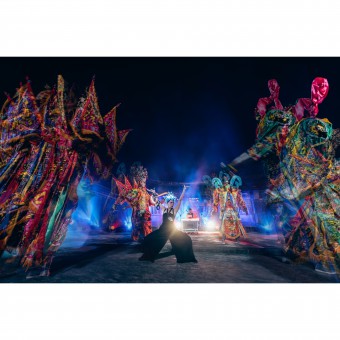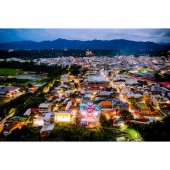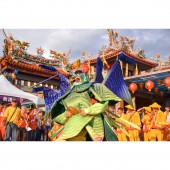Daxi Daxi Local Culture Festival by BIAS Architects and Associates |
Home > Winners > #123023 |
 |
|
||||
| DESIGN DETAILS | |||||
| DESIGN NAME: Daxi Daxi PRIMARY FUNCTION: Local Culture Festival INSPIRATION: Usually, Taiwanese religious ceremonies are conservative and based on rural traditions that strictly dictate parade rules. To share the charm of the folk beliefs with the urban public, BIAS tried to mediate the ancient traditions by a strategic set of design interventions and educational activities that could provide a contemporary pop culture vibe to the festival. UNIQUE PROPERTIES / PROJECT DESCRIPTION: Lord Guan's birthday celebration is an important traditional event held in the rural outskirts of Taipei. The local people call it "the second Chinese New Year for Daxi," and everyone in the township of Daxi uses to put significant effort into the preparations. Tasked to preserve and promote the event, since 2018, BIAS has developed and implemented an urban festival to help the township preparing for the celebration. The festival has been named "Daxi Daxi," i.e., a play of words that means "Good Luck Daxi." In particular, in 2020, the third installment of "Daxi Daxi," the "Lord Guan Online" concept was implemented, i.e., a creative offline and online approach that 'allows the god's blessings to spread far away' through the new media. This festival strengthened the local community's identity, but the last installment attracted more than 100,000 people to the township. Besides this, an exhibition focused on the "backstage" OPERATION / FLOW / INTERACTION: The key aspects of the festival are to be found in the mixing of various aspects of the traditional parade rules and preparations with popo-culture and aesthetics. In particular, while the traditional aspects were not obliterated or negated in their functionality, touches of a new aesthetics were added and communicated to the large public as the product of a new pride of the local community. PROJECT DURATION AND LOCATION: The event starts in mid-July and finishes in mid-August each year since 2018 in Daxi, Taiwan. The last installment was held in 2020. |
PRODUCTION / REALIZATION TECHNOLOGY: The main concept of Daxi Daxi is to combine traditions and pop culture so as to both rejuvenate the audience of Taiwanese religious festivals and deepen the understanding of these by the young generations. In order to achieve this, a curatorial approach was adopted, focused on selecting a series of young artists and designers that could cooperate with those holding the traditions. Most importantly, the artists, designers, and the holders of traditions were supported by BIAS that mediated their cooperation so as to ease their efforts and bring it to a good end. That is to say, BIAS initiated their encounter and acted as a facilitator and translator of their different point of view. SPECIFICATIONS / TECHNICAL PROPERTIES: Total event area: 121,000 sqm TAGS: festival, traditional rural culture, urban pop culture, religion, parade, design as mediation, curating RESEARCH ABSTRACT: The research was developed on various aspects, including the following. First of all, it was developed a deep understanding of ancient rituals and those people that carry on the traditions today. Then, it was developed curatorial research on a set of artists and designers that could develop a dialogue and thus intervene in the strategic renewal of traditions. Finally, mediatory research was implemented in order to help the community and the designers collaborate for the good end. CHALLENGE: The key challenge of the project was at the curatorial level. In particular, it was the selection of third-party artists and designers that could dialogue with those today bringing forward the ancient traditions. Not only but also, it was to create proper occasions for the encounter of these seemingly opposite actors. ADDED DATE: 2021-03-06 07:42:40 TEAM MEMBERS (1) : Main Curator: BIAS Architects & Associates IMAGE CREDITS: Image #1: Photographer Yu Dong, 2019 Image #2: Photographer Yu Dong, 2020 Image #3: Photographer Jia-Ying Yang, 2019 Image #4: Photographer Yu Dong, 2018 Image #5: Photographer Jia-Ying Yang, 2018 |
||||
| Visit the following page to learn more: https://www.biasarchitects.com/202daxida |
|||||
| AWARD DETAILS | |
 |
Daxi Daxi Local Culture Festival by Bias Architects and Associates is Winner in Event and Happening Design Category, 2020 - 2021.· Read the interview with designer BIAS Architects and Associates for design Daxi Daxi here.· Press Members: Login or Register to request an exclusive interview with BIAS Architects and Associates. · Click here to register inorder to view the profile and other works by BIAS Architects and Associates. |
| SOCIAL |
| + Add to Likes / Favorites | Send to My Email | Comment | Testimonials | View Press-Release | Press Kit | Translations |
Did you like Bias Architects and Associates' Event Design?
You will most likely enjoy other award winning event design as well.
Click here to view more Award Winning Event Design.








